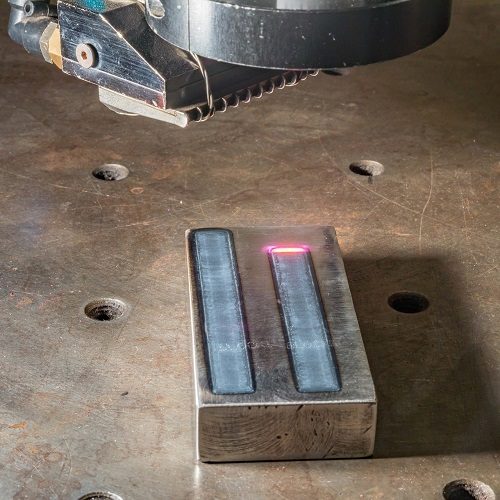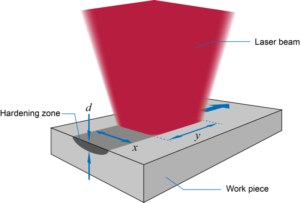What is Laser Hardening?


Hardening is one of the oldest metallurgical processes known to mankind. In olden times, swords were heated and dipped into water to achieve hardness. In conventional hardening, the work-piece is heated to a very high temperature using a furnace, or a customized coil is prepared according to the geometry of the work-piece and then this coil is heated by AC current and brought into the vicinity of the workpiece.
In this way, the component is heated to a very high temperature, then it is quenched in oil or water. However, conventional hardening has some shortcomings. Firstly, it is time consuming because turnaround time required in conventional furnace based hardening is more or in case coil is used, custom coil is to be prepared according to geometry of each component.
After that, it requires quenching, and due to all this, there is distortion in the workpiece so it requires post processing. Laser Hardening is a modern method and solves all these problems. It is a case hardening process in which a laser beam is used to heat the surface of the component in a precisely temperature controlled way. Due to high precision, only that part of the component which needs to be hardened is heated, and the bulk of the material acts as the heat sink, producing a self quenching effect.
Distortion is very low or close to nil, so no post processing required. Laser Hardening can also be used as the final process on a finished product.


Applications of Laser Hardening
Laser hardening is used to locally improve wear resistance, hardness and fatigue life of a material. This method is ideal for case hardening, and for complex geometries where precision is critical. It is ideal because minimum heat is transferred to surrounding material. Laser hardening is used in various industries, including automotive, aerospace, and tool and die manufacturing. It is particularly useful for hardening complex shapes and small parts, where traditional heat treatment methods may not be feasible. Laser hardening can also be used for selective hardening of specific areas of a part, which can reduce the risk of distortion and minimize the amount of material that needs to be hardened.
Aerospace and defense: Laser hardening is used to harden critical aerospace and defense components such as landing gear, engine parts, and missile guidance systems, to improve their durability and resistance to wear.
Automotive industry: Laser hardening is used in the automotive industry to harden engine components, such as crankshafts, camshafts, and valve stems, to increase their wear resistance and improve their overall performance.
Medical industry: Laser hardening is used to harden surgical instruments, such as scalpels and forceps, to increase their durability and reduce the need for frequent replacement.
Tool and die industry: Laser hardening is used to harden cutting tools, dies, and molds, to improve their wear resistance and prolong their service life.
Construction and mining equipment: Laser hardening is used to harden wear parts such as buckets, shovels, and blades, used in construction and mining equipment, to improve their durability and resistance to wear and tear.
Also, laser hardening is used in many applications
- Increasing hardness of cutting tools:
In cutting/ turning tools, the hardness of the tools material must be considerably higher than the hardness of the material workpiece. Laser hardening gives the desired results. - Transmission components like cams, camshafts, sprockets, gears , racks and pinions etc.
- It has Applications in press forming tools.
- In earth moving equipment, surface is required to have high hardness and abrasion resistance. But using hard material altogether makes it brittle, hence increasing chances of fracture and cracks. Laser hardening is used to harden just the surface with penetration precisely as required, hence, giving advantage of high abrasion and wear resistance without compromising or making the material brittle.
Advantages of laser hardening:
- High precision: Laser hardening is a precise process that can be used to harden specific areas of a part with a high degree of accuracy.
- Fast process: Laser hardening is a fast process that can produce a hardened layer in a matter of seconds.
- Minimal distortion: Laser hardening generates less heat than traditional heat treatment methods, which reduces the risk of distortion and warping.
